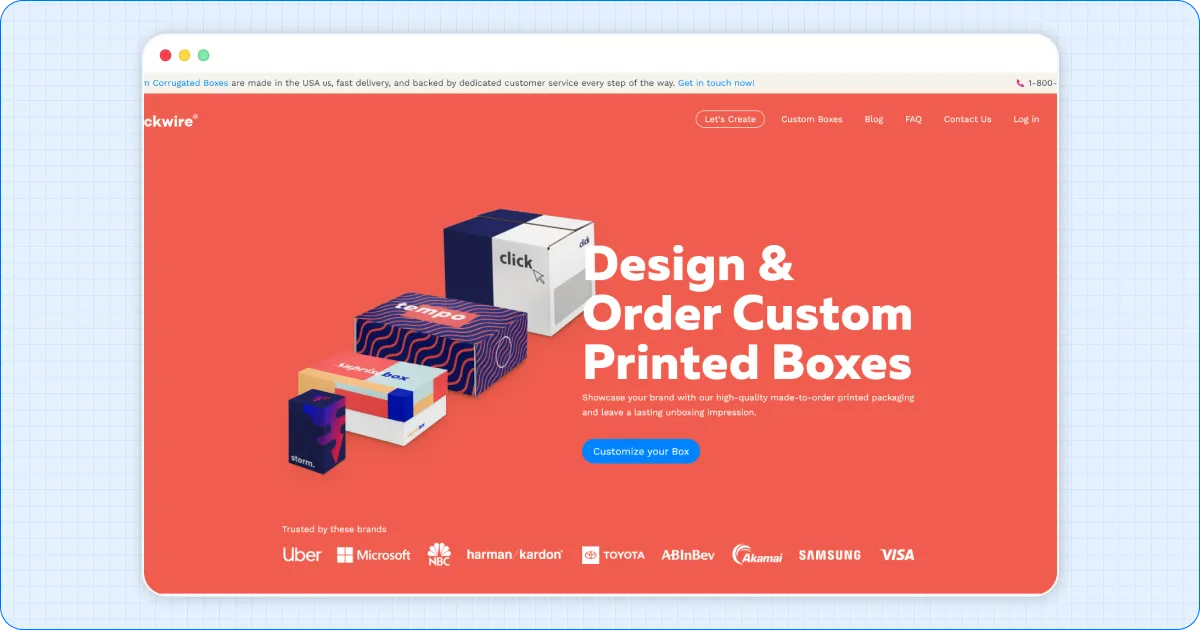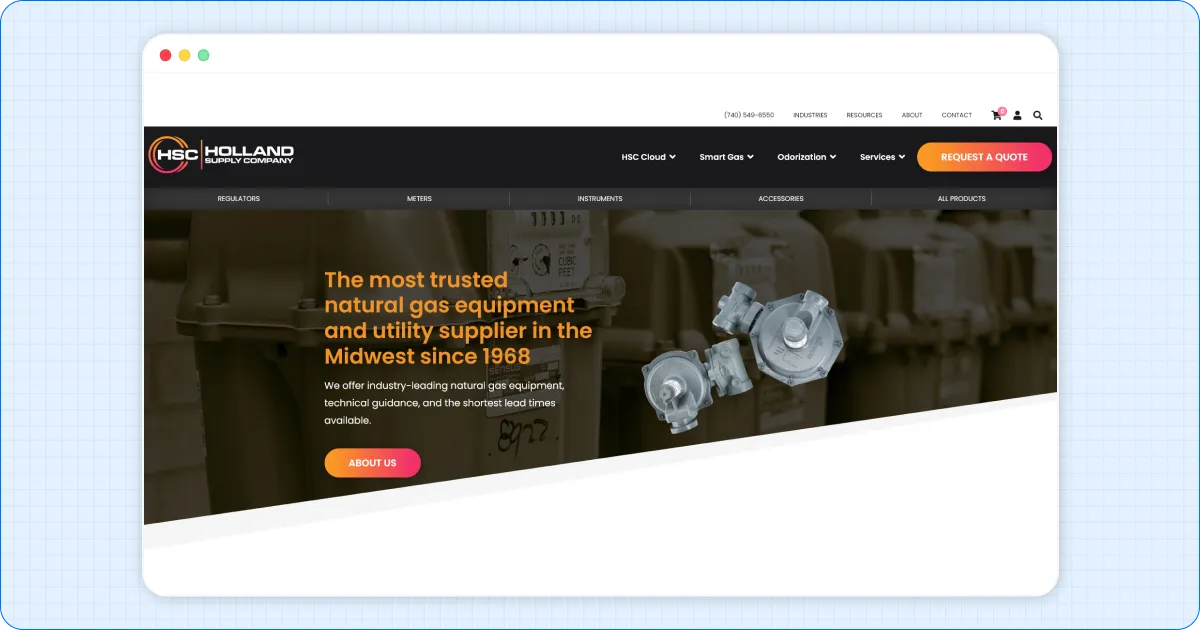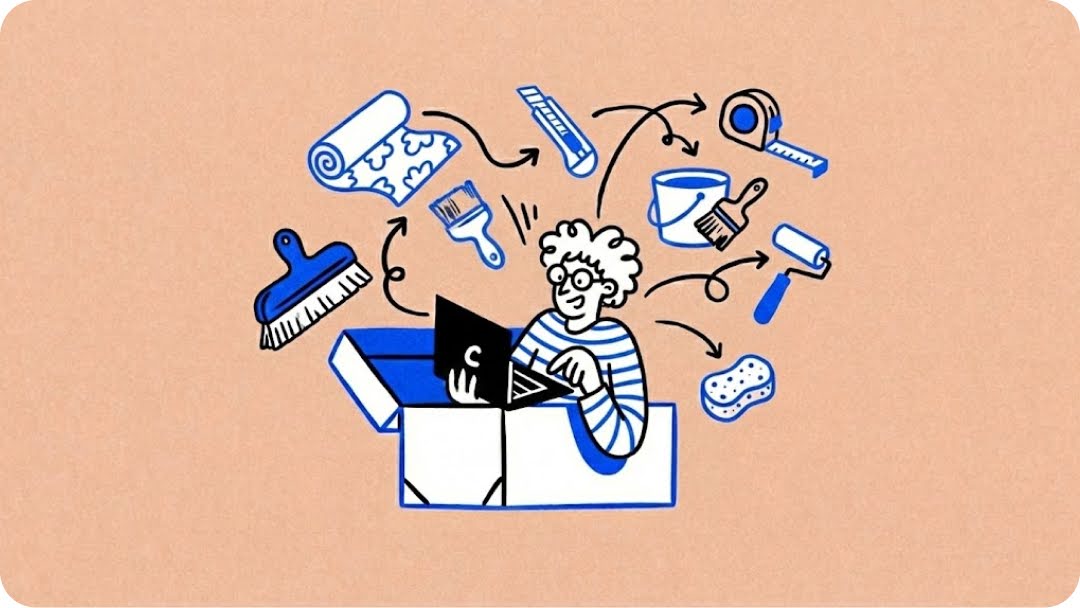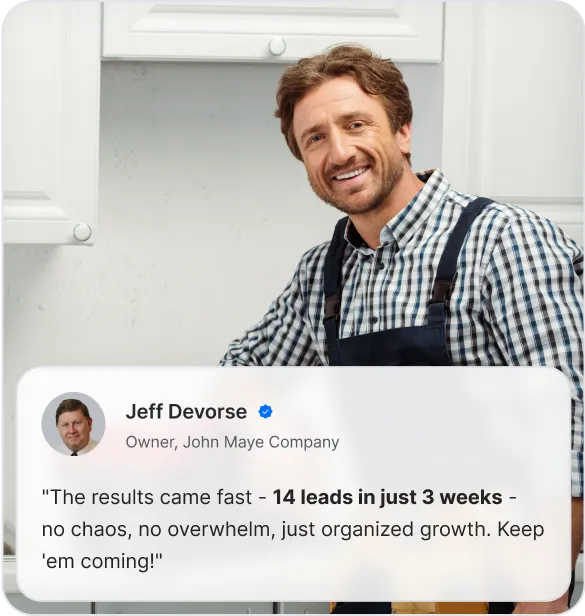A great manufacturing product isn’t enough!
Six months ago, a major automotive company needed custom-machined components. Tight tolerances. 50,000-unit order. Right in your wheelhouse.
They searched online. Your competitor's website loaded instantly with case studies, an ROI calculator, and a "Get Quote in 24 Hours" button.
Your website? "Welcome to ABC Manufacturing," with that 2018 building photo.
They called your competitor. You never knew they existed.
The agenda is simple to understand. Your website is often the first point of contact for potential customers, and if it's not optimized to generate leads, you're leaving money on the table.
A well-designed manufacturing website doesn't just showcase your products; it builds trust, demonstrates expertise, and guides visitors toward a conversion.
To help you get inspired, we've compiled a list of over 25 manufacturing website examples that are doing it right. We'll also provide a strategic checklist you can use to audit your own site and turn it into a lead-generating machine.
TL;DR
- Small Operations (Under $5M) Website Examples: Path Robotics, Marley, Kongskilde Industries, Energy Park, VJTechnologies, FasTest Connectors, C.H.I. Overhead Doors, Amazon Filters, Hajster
- Mid-Size Manufacturers ($5M-$500M) Website Examples: Packwire, Airthings, Micro Weld, Dover Tubular Alloys, McNally Industries, Holland Supply Company, HydroPoint, Halco USA, WIC
- Industry Giants ($500M+) Website Examples: Siemens Manufacturing, Caterpillar, 3M Manufacturing, Honeywell Industrial, Emerson Electric, Minnesota Rubber & Plastics, SuperMax Tools, NXP Semiconductors
- The 5 Success Patterns: What every lead-generating manufacturing website does (it's simpler than you think) + PDF Checklist included
- Realistic Implementation Guide: Budgets ($10K-$150K), platforms, and 6-16 week timelines based on your company size
- Real Results Proof: See how one B2B company got 300% more leads using these same strategies
A. Small Manufacturing Operations (Under $5M Revenue)
"Local Focus, Personal Touch, Speed Advantage"
Running a smaller manufacturing operation? You know the challenge.
Bigger companies. Deeper pockets. More resources.
But the smart ones quickly figured out that the websites help you compete with bigger companies without spending more money.
The manufacturers listed below will prove that you don't need Fortune 500 budgets to get Fortune 500 results. They're using their natural advantages like speed, personal service, and local expertise to steal business from the big guys.
Example 1: Path Robotics - AI-Powered Welding Systems

Why It Works: This $50M robotics company goes head-to-head with billion-dollar automation giants, and wins deals because its website works smarter, not harder.
Smart Positioning:
- Clear Value Proposition: Instead of confusing tech jargon, they lead with "Autonomous Welding Powered by AI Technology", so that anyone can understand what they do in 5 seconds.
- ROI Calculator: Prospects punch in their welding volume and instantly see potential savings. No waiting for a sales call to get ballpark numbers
- 24-Hour Demo Guarantee: While big competitors take weeks to respond, they promise demos in 24 hours
- Customer Success Stories: Real customer names with real results—not generic "Client A saved 30%" stories
- Mobile Excellence: Their site loads quickly on phones, featuring one-tap calling and mobile-optimized quote forms, ideal for engineers researching during plant visits.
What You Can Apply: Stop trying to be everything to everyone. Path Robotics focuses solely on AI welding systems. Pick your specialty and own it. Then create simple tools (even a basic calculator) that help prospects see the value before they call you.
Example 2: Marley Building Products - Roofing Systems

Why It Works: This mid-size building products company goes up against Home Depot and Lowe's every day. It wins because they make it easier for contractors to choose and use their products.
Visual Problem-Solving:
- 3D Product Visualization: Instead of flat product photos, contractors can see exactly how roofing components fit together before ordering
- Installation Resource Center: All the technical docs, installation guides, and specifications in one place, no digging through multiple PDFs
- Project Gallery: Photos of their products on real buildings, not just warehouse shots
- Contractor Locator: Homeowners can find certified installers in their area, creating a win-win for everyone
What You Can Apply: Stop showing just product photos. Show your products doing the job they were made for. If you work through distributors or dealers, make their lives easier. Give them the tools that help them sell your products. When you support your channel partners, they'll push your products over the competition.
Example 3: Kongskilde Industries - Pneumatic Conveying Systems

Why It Works: This global conveying systems company could have built a single generic website, but instead, they created separate experiences for grain farmers and industrial manufacturers, and it's paying off with higher-quality leads.
Multi-Market Approach:
- Separate Industrial and Grain Pathways: A grain elevator operator and a chemical plant manager have completely different needs, so they get completely different website experiences
- Application-Specific Landing Pages: Instead of one confusing "conveying systems" page, they have dedicated sections for material handling, food processing, and chemical applications
- Technical Resource Library: Engineers can download system design guides, sizing calculators, and installation specifications without jumping through hoops
What You Can Apply: If you serve different industries, don't force them all through the same front door. Create separate paths for your main customer types. And don't dumb down the technical information; the engineers evaluating your equipment actually want more detail, not less.
Example 4: Energy Park - EV Charging Infrastructure

Why It Works: This charging station manufacturer recognized something important for their viewers. Today's buyers don't just want functional products; they want to feel good about their purchasing decisions.
Sustainability Focus:
- Environmental Impact Calculator: Prospects can see exactly how many tons of CO2 they'll save by installing these charging stations, giving them concrete numbers for board presentations
- Dynamic Hero Video: Instead of boring product shots, visitors see charging stations in action at busy locations with real cars and real people
- Future-Focused Messaging: They position their products as infrastructure investments, not just equipment purchases
What You Can Apply: Modern buyers, especially younger engineers and facility managers, care about more than just specs and price. If your products help customers save energy, reduce waste, or work more safely, make that a big part of your story. And replace those static product photos with videos that show your equipment actually working.
Example 5: VJTechnologies - Radar Detection Systems

Why It Works: This radar systems manufacturer could have built a basic industrial website. Still, they chose to look as sophisticated as their technology, and it attracts customers who appreciate (and pay for) high-end engineering.
Premium Brand Positioning:
- Dark, Sophisticated Design: The website looks like it belongs to a high-end tech company, not a traditional manufacturer, which is exactly the impression they want to make
- Clear Information Hierarchy: Bold headings and strategic use of color guide visitors to the most important information without overwhelming them
- Technical Credibility: All the detailed specifications, technical documents, and engineering data are easy to find; no hiding behind "contact us for details."
What You Can Apply: If you manufacture precision or high-tech products, don't be afraid to look the part. A professional website design tells prospects they can expect professional results from your products. And if your products are complex, show that complexity proudly. Engineers trust companies that understand the technical details.
Example 6: FasTest Connectors - Engineered Sealing Solutions

Why It Works: This connector manufacturer solved a common problem—engineers need standard parts fast, but they also need custom solutions for special projects. So they built a website that handles both.
Engineer-Focused Design:
- Product Finder Tool: Engineers punch in their pressure, temperature, and material requirements and get a list of connectors that will work. No guessing or lengthy phone calls
- Technical Resource Center: CAD files for immediate download, installation guides, and compatibility charts all in one place
- E-Commerce Integration: Standard connectors can be ordered online with immediate pricing and delivery dates
What You Can Apply: You don't have to choose between online sales and custom manufacturing. Handle the routine orders online so your sales team can focus on the complex, high-value custom work. Provide engineers with the technical resources they need to specify your products accurately the first time.
Example 7: C.H.I. Overhead Doors - Garage Door Manufacturing

Why It Works: This regional garage door manufacturer goes up against Clopay and other national brands every day. However, they win by making it easier for customers to get exactly what they want, exactly where they are.
Customer-Centric Approach:
- Product Configurator: Homeowners can design their ideal garage door online, see what it looks like on their house, and get instant pricing, no waiting for a sales visit
- Residential/Commercial Split: A homeowner and a warehouse manager need completely different information, so they get completely different experiences from the first click
- Local Dealer Integration: The website connects customers directly to certified installers in their area, making the whole process seamless
What You Can Apply: Use your local advantage. While national companies have to be everything to everyone, you can focus on serving your region better than anyone else. Make it easy for customers to find local dealers, installers, or service providers. And if possible, let customers configure or customize products online—even a basic version beats making them call for every little detail.
Example 8: Amazon Filters - Industrial Filtration Systems

Why It Works: This filtration company offers thousands of different filters, and they've realized something important. If customers can't find the right filter quickly, they'll go somewhere else that makes the process easier.
Search and Discovery:
- Advanced Product Search: Instead of scrolling through endless pages, customers filter by their specific application (HVAC, industrial, automotive), material type, and required certifications
- Visual Product Gallery: Every filter has multiple high-quality photos showing different angles, plus all the technical specifications right there—no clicking to separate spec sheets
- Live Chat Support: When customers get stuck trying to find the right filter, they can instantly connect with a technical expert who actually knows the products
What You Can Apply: If you offer a wide range of products, don't require customers to search for what they need. Create simple ways to filter and search your product catalog. Place the key specifications directly on the product pages, rather than burying them in downloadable PDFs. And make it easy to get help from someone who knows your products inside and out.
Example 9: Hajster - Industrial Pumps

Why It Works: This pump manufacturer made a bold choice. Instead of looking like every other industrial website, they decided to showcase their precision pumps like works of art.
Creative Differentiation:
- Artistic Product Photography: Their pumps are photographed like precision machinery, showing the craftsmanship and quality that goes into each piece
- Dynamic Animations: Subtle movements and transitions guide visitors' attention without being distracting or gimmicky
- Modern Typography: Clean, contemporary fonts that appeal to younger engineers and purchasing managers who are increasingly making buying decisions
What You Can Apply: Don't assume industrial buyers want boring websites. The next generation of engineers and facility managers grew up with smartphones and expect better design. If your products are precision-made, show that precision in how you present them.
Sometimes, standing out from the crowd of generic industrial websites is exactly what gets you noticed.
B. Mid-Size Manufacturers ($5M-$500M Revenue)
"Too Big for Local, Too Small for Giants"
You're in the toughest spot.
Too big to compete on local relationships alone. Not big enough to outspend industry giants.
But that's exactly where these companies found their advantage. They stopped trying to be everything to everyone and started dominating specific niches.
Example 10: Packwire - Custom Packaging Solutions

Packwire built an interactive design tool that lets customers create mockups instantly and order same-day samples. While big packaging companies make customers wait weeks for samples and quotes, Packwire delivers both in 24 hours.
Your takeaway here is simple. Speed beats size. Find one thing you can do faster than the big players and make it your competitive advantage online.
Example 11: Airthings - Environmental Monitoring Equipment

Airthings created separate website paths for homeowners (simple DIY setup) and businesses (technical specifications and compliance data). A facilities manager and a homeowner need completely different information about air quality monitors, so they get distinct experiences from the first click.
Your takeaway here should be easy. If you serve both consumers and businesses, don't force them through the same front door. Create clear paths for each audience.
Example 12: Micro Weld - Precision Welding Equipment

Micro Weld built a smart filtering system that lets customers find the exact welder for their metal type, industry, and welding requirements in seconds. Instead of scrolling through 100+ welders, customers filter by their specific needs and see only relevant options. Plus, "Nearly 100 Years of Experience" builds instant credibility.
Your takeaway here is that if you have a complex product line, make it searchable. And if you've been around for decades, use that experience as proof you know what you're doing.
Example 13: Dover Tubular Alloys - Industrial Tubing Distribution

Dover's website clearly states "B2B wholesale only" and optimizes everything for fast reordering with no time wasted on retail customers. Purchasing agents can quickly filter by tube specifications, see availability, and reorder standard materials without phone calls or emails.
Your takeaway here is that if you only serve specific customer types (wholesale, retail, etc.), say so upfront. Then optimize everything for how those customers actually buy from you.
Example 14: McNally Industries - Defense & Aerospace Manufacturing

McNally uses conservative, professional design with heavy emphasis on quality certifications and compliance standards—exactly what government contractors expect to see. Defense buyers don't want flashy websites; they want proof you can meet strict quality and security requirements.
Your takeaway here is easy. You should match your website style to your industry's expectations. If you serve conservative industries, look conservative. If you serve creative industries, show some personality.
Example 15: Holland Supply Company - Industrial Gas & Utility Equipment

New ownership scrapped Holland's old website entirely and built a custom e-commerce platform designed specifically for their industry. Instead of trying to patch up an outdated website, they started fresh with a system built for how their customers actually buy gas and utility equipment.
Your takeaway is simple. Sometimes a complete rebuild works better than endless tweaks. If your current website can't grow with your business, it might be time to start over.
Example 16: HydroPoint - Smart Water Management Systems

HydroPoint designed its mobile-optimized website for irrigation managers who research solutions while standing in fields, not sitting at desks. Field-based buyers use their phones to research equipment on-site, and HydroPoint's website works perfectly on mobile with easy contact options.
What you should do is optimize for mobile-first if your customers work in the field (construction, agriculture, utilities). They're researching your products while standing next to broken equipment.
Example 17: Halco USA - Specialty Fastener Manufacturing

Halco created separate landing pages for automotive, aerospace, medical, and hygiene applications, each speaking that industry's specific language. A medical device engineer and an automotive engineer need different certifications, specifications, and compliance information for the same basic fastener.
Your takeaway is easy. If you serve multiple industries, create industry-specific pages. Don't make an aerospace engineer dig through automotive applications to find what they need.
Example 18: WIC (Western Industries Corporation) - Multi-Market Manufacturing

WIC added a Spanish language option, recognizing that many of their customers prefer to research and buy in their native language. Instead of losing potential customers who struggle with English-only websites, WIC makes it easy for Spanish-speaking buyers to understand their products and place orders.
Your takeaway is that if a significant portion of your customers speaks another language, add that language to your website. It shows you understand and value their business.
C. Industry Giants ($500M+ Revenue)
"Billion-Dollar Strategies You Can Use Today"
These companies didn't get big by accident. They use proven website strategies that started simple and scaled up. Here's what they figured out, and how you can use the same principles without the massive budget.
Example 19: Siemens Manufacturing - Global Industrial Automation

What They Do: 40+ language versions, AI-powered search across 100,000+ products, digital twin showcases, and regional compliance centers for every country they serve.
What You Can Do: Start with 2-3 languages for your actual markets, basic product filtering, video demonstrations of your equipment working, and highlight your relevant certifications prominently.
The Core Principle: Make it easy for customers to find what they need in the language and format they prefer.
Budget Reality: Siemens spends millions on global infrastructure. You can get 80% of the benefit with WordPress multilingual plugins ($200/year) and organized product pages.
Example 20: Caterpillar - Heavy Equipment & Machinery

What They Do: Real-time inventory tracking across 190+ countries, custom equipment configurators with instant pricing, enterprise fleet management portals, and VR showroom experiences.
What You Can Do: Simple dealer locator with Google Maps, basic product configurator using quote forms, customer login area for repeat buyers, and 360-degree product videos.
The Core Principle: Make it easy for customers to find local support and configure products without endless phone calls.
Budget Reality: Caterpillar's global infrastructure costs millions. You can deliver similar convenience with Google Maps (free) and basic form builders ($50/month).
Example 21: 3M Manufacturing - Diversified Technology

What They Do: Manage 60,000+ products across dozens of industries with smart segmentation, showcase their R&D pipeline and patent portfolio, maintain massive technical libraries, and integrate real-time global supply chain tracking.
What You Can Do: Focus on 3-4 main industries maximum, highlight your latest products and improvements, organize PDF guides and spec sheets logically, and send simple email order updates.
The Core Principle: Don't overwhelm customers—guide them to exactly what they need for their specific industry and application.
Budget Reality: 3M's product management system costs millions. You can organize your offerings effectively with WordPress industry pages and basic email automation tools.
Example 22: Honeywell Industrial Solutions - Process Automation

What They Do: Industry-specific ROI calculators, interactive process optimization tools, comprehensive safety compliance databases, and predictive analytics dashboards with IoT integration.
What You Can Do: Basic cost savings calculator, downloadable efficiency checklists, key regulation summaries, and before/after case studies showing measurable customer improvements.
The Core Principle: Help customers justify your solution internally by showing concrete business benefits, not just product features.
Budget Reality: Honeywell's advanced analytics cost millions to develop. You can help customers see value with embedded Google Sheets calculators and well-documented case studies.
Example 23: Emerson Electric - Automation Solutions

What They Do: Complete industry-specific portals for oil & gas, chemical, and power generation, comprehensive engineering tool suites, full learning management systems, and integrated partner collaboration platforms.
What You Can Do: One focused landing page per main industry, simple calculators and selection guides, an organized resource center with training materials, and a basic partner directory listing certified installers.
The Core Principle: Different industries have different needs—create separate experiences rather than forcing everyone through the same generic funnel.
Budget Reality: Emerson's industry portals cost millions to build and maintain. You can serve different industries effectively with focused landing pages and basic tools ($30/month).
Example 24: Minnesota Rubber & Plastics (MRP) - Custom Materials

What They Do: Comprehensive material property database with thousands of compounds, guided custom solution wizards, showcases of ISO, AS9100, and medical device certifications, and global manufacturing network integration.
What You Can Do: Simple material comparison charts, step-by-step quote forms for custom projects, prominently display your ISO, AS9100, or other quality certifications, and a clear capability overview explaining what you can manufacture.
The Core Principle: For custom manufacturing, help customers understand their options and guide them through the specification process step by step.
Budget Reality: MRP's material database costs hundreds of thousands to maintain. You can help customers choose materials with comparison tables and multi-step forms ($15/month).
Example 25: SuperMax Tools - Woodworking Equipment

What They Do: Dual audience pathways for hobbyists versus commercial users, video-rich product pages with multiple demonstration tabs, an interactive dealer network with real-time inventory, and user community features with project galleries.
What You Can Do: Clear entry points for different customer types (retail vs. commercial), product demo videos showing your equipment in action, a simple dealer finder listing distributors or service centers, and a customer gallery with project photos.
The Core Principle: If you serve both consumer and commercial markets, create separate experiences—a weekend woodworker and a cabinet shop need completely different information.
Budget Reality: SuperMax's interactive dealer network costs thousands to maintain. You can serve different audiences with YouTube videos, Google Maps, and a simple customer photo gallery.
Example 26: NXP Semiconductors - Technology Manufacturing

What They Do: Application-focused navigation for automotive, IoT, mobile, and infrastructure segments, comprehensive technical documentation portals, design support ecosystem with field application engineer access, and real-time global logistics integration.
What You Can Do: Show your products in real-world use cases, organize datasheets and technical guides logically, provide clear contact methods for technical support, and simple availability indicators for key products.
The Core Principle: For complex technical products, organize information by how customers actually use your products, not by your internal product categories.
Budget Reality: NXP's global logistics system costs millions to integrate. You can help customers find technical information with an organized download center and basic inventory status updates.
How Do You Know These Manufacturing Websites Actually Work?
You just saw 26 manufacturing websites, but here's what makes this list different from every other "best website" roundup you've seen.
We Didn't Pick Pretty Designs. We Picked Lead-Generating Ones
We didn't choose these websites because they look good in screenshots or win design awards. We chose them because they actually generate qualified leads and sales calls for manufacturing businesses.
Here's How We Evaluated Lead Generation:
- Conversion Performance: Do they actually generate qualified inquiries that turn into sales calls? We looked for websites where the phone rings with serious prospects, not just tire-kickers.
- Lead Capture Design: Are the contact forms, quote requests, and call-to-action buttons designed for how manufacturing buyers actually behave?
(Hint: they're usually researching on mobile during facility visits or between meetings.) - Mobile Lead Generation: Do they capture leads from prospects researching on smartphones and tablets?
Because 60% of B2B research now happens on mobile devices. - Measurable Results: Can we verify that these websites actually increased lead volume and quality?
We looked for companies that could point to real business growth from their website investments.
Why Should You Consider Company Sizes While Looking at Website Design?
Most "best website" lists always make a critical mistake. They either focus only on Fortune 500 giants (with completely unrealistic budgets for most manufacturers) or only showcase small companies (which limits your growth vision).
We took a different approach: We analyzed the entire manufacturing ecosystem, from $1M local machine shops to $50B global leaders, because the most effective strategies often work across different company sizes when adapted correctly.
You saw examples from:
- Your Current Peer Group: Companies with realistic budgets and challenges you can relate to. These show what's possible to implement in the next 6-12 months with your current resources.
- Companies One Size Up: Growing manufacturers who've figured out how to scale their lead generation. These reveal the strategies you'll want to adopt as you grow.
- Industry Leaders: Billion-dollar companies whose proven principles you can adapt to your scale. Their basic strategies often started when they were much smaller, before they had massive budgets.
The key takeaway here is that those industry giants didn't start with billion-dollar marketing budgets. Many of their most effective website strategies began when they were exactly your size, facing the same challenges you face today.
Your Next Step is Simple. Building a Manufacturing Website That Converts
Ready to put these strategies into action? Here's your step-by-step roadmap:
First Step. A Simple Budget & Platform Guide
Second Step is Your Implementation Timeline – When You'll See Results
Here’s a simple roadmap for your ROI Timeline.
Small Operations (6-10 weeks)
Growing Manufacturers (10-16 weeks)
Bottom Line: Your website investment should pay for itself within 12 months through increased lead quality and volume. If it doesn't, something's wrong with the strategy.
Here's Proof These Strategies Work – How Pazago Transformed Their Lead Generation

THE CHALLENGE
Pazago faced the same challenge every growing B2B company faces: their website looked professional, but it wasn't converting visitors into qualified leads.
Sound familiar? They applied the exact same principles you just learned.
THE RESULTS
Let Pazago's results speak for themselves:
- 300% increase in qualified leads within 6 months
- $2.3M in additional revenue directly from website improvements
- 890% ROI on their website investment
- 45% improvement in lead-to-customer conversion
THE STRATEGY
They applied the same principles you just learned:
- Mobile-first design for on-the-go buyers
- Conversion-focused layouts that guide prospects
- Strategic lead capture without being pushy
- Systematic follow-up for long sales cycles
WHY THIS MATTERS TO YOU
While Pazago operates in B2B logistics, they faced the exact same challenge you're facing right now.
The strategies that work for precision manufacturers work for any B2B company. The patterns that convert industrial buyers convert business executives.
READ THE COMPLETE PAZAGO CASE STUDY HERE
Frequently Asked Questions (FAQs)
1. Is there an AI for website design?
Yes, several AI tools help with website design, including Wix ADI, Bookmark, and 10Web. However, for manufacturing businesses, these tools often create generic sites that don't convert visitors into leads. While AI can handle basic design, manufacturing websites need industry-specific features like product configurators, technical resource centers, and lead capture assistance from companies like Gushwork that provide human expertise to implement effectively.
2. How much does it cost to get a website made for a business?
Business websites typically cost $3,000-$150,000, depending on complexity. For manufacturing companies, expect $10,000-$50,000 for small operations and $25,000-$150,000 for growing manufacturers. This includes mobile optimization, lead generation systems, and technical content creation. Template-based sites cost less ($1,000-$5,000) but often fail to generate qualified leads for industrial businesses.
3. What is an OEM website?
An OEM (Original Equipment Manufacturer) website showcases companies that design and manufacture products sold by other businesses under different brand names. These sites typically focus on B2B audiences, highlighting manufacturing capabilities, quality certifications, production capacity, and technical specifications. OEM websites emphasize reliability, compliance standards, and the ability to scale production for partner companies.
4. Who owns the rights to design a website?
Website design ownership depends on your contract with the designer or agency. Typically, you own the content and final website, while the designer retains rights to design elements and code they created. Always clarify ownership in writing before starting. For manufacturing companies, ensure you own your website completely, including technical content, product specifications, and customer data, so you can make updates independently.
5. Why do most manufacturing websites look terrible?
Most manufacturing websites look outdated because many manufacturers view websites as "necessary expenses" rather than sales tools. They often prioritize production over digital presence, use outdated design firms, or try DIY solutions. Additionally, manufacturing decision-makers sometimes assume industrial buyers don't care about website quality, but 77% of B2B buyers research online first, making professional web design crucial for winning contracts.




















.webp)








.webp)
.svg)


.svg)
.svg)
.svg)




.svg)





.svg)